
The Pacific Electric Railway Company, nicknamed the Red Cars, was a privately owned mass transit system in Southern California consisting of electrically powered streetcars, interurban cars, and buses and was the largest electric railway system in the world in the 1920s. Organized around the city centers of Los Angeles and San Bernardino, it connected cities in Los Angeles County, Orange County, San Bernardino County and Riverside County.

The interurban is a type of electric railway, with tram-like electric self-propelled rail cars which run within and between cities or towns. The term "interurban" is usually used in North America, with other terms used outside it. They were very prevalent in North America between 1900 and 1925 and were used primarily for passenger travel between cities and their surrounding suburban and rural communities. The concept spread to countries such as Japan, the Netherlands, Switzerland, Belgium, Italy and Poland. Interurban as a term encompassed the companies, their infrastructure, their cars that ran on the rails, and their service. In the United States, the early 1900s interurban was a valuable economic institution, when most roads between towns, many town streets were unpaved, and transportation and haulage was by horse-drawn carriages and carts.
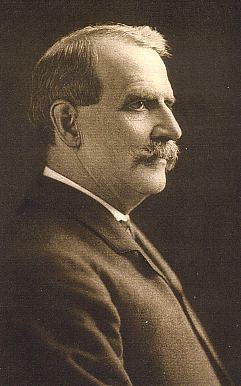
Henry Clay Payne was U.S. Postmaster General from 1902 to 1904 under Pres. Theodore Roosevelt. He died in office and was buried at Forest Home Cemetery in Milwaukee, Wisconsin. He was also a chairman of the Republican National Committee.

New York State Railways was a subsidiary of the New York Central Railroad that controlled several large city streetcar and electric interurban systems in upstate New York. It included the city transit lines in Rochester, Syracuse, Utica, Oneida and Rome, plus various interurban lines connecting those cities. New York State Railways also held a 50% interest in the Schenectady Railway Company, but it remained a separate independent operation. The New York Central took control of the Rochester Railway Company, the Rochester and Eastern Rapid Railway and the Rochester and Sodus Bay Railway in 1905, and the Mohawk Valley Company was formed by the railroad to manage these new acquisitions. New York State Railways was formed in 1909 when the properties controlled by the Mohawk Valley Company were merged. In 1912 it added the Rochester and Suburban Railway, the Syracuse Rapid Transit Railway, the Oneida Railway, and the Utica and Mohawk Valley Railway. The New York Central Railroad was interested in acquiring these lines in an effort to control the competition and to gain control of the lucrative electric utility companies that were behind many of these streetcar and interurban railways. Ridership across the system dropped through the 1920s as operating costs continued to rise, coupled with competition from better highways and private automobile use. New York Central sold New York State Railways in 1928 to a consortium led by investor E. L. Phillips, who was looking to gain control of the upstate utilities. Phillips sold his stake to Associated Gas & Electric in 1929, and the new owners allowed the railway bonds to default. New York State Railways entered receivership on December 30, 1929. The company emerged from receivership in 1934, and local operations were sold off to new private operators between 1938 and 1948.

The Chicago North Shore and Milwaukee Railroad, also known as the North Shore Line, was an interurban railroad that operated passenger and freight service over an 88.9-mile (143.1 km) route between the Chicago Loop and downtown Milwaukee, as well as an 8.6-mile (13.8 km) branch line between the villages of Lake Bluff and Mundelein, Illinois. The North Shore Line also provided streetcar, city bus and motor coach services along its interurban route.

Kenosha Area Transit is a city-owned public transportation agency based in Kenosha, Wisconsin.
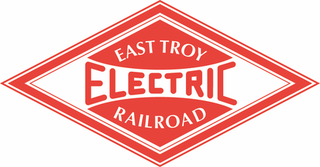
The East Troy Electric Railroad is an interurban heritage railroad owned and operated by the East Troy Railroad Museum. Passenger excursions run on a 7-mile (11 km) stretch of track from East Troy to Mukwonago, Wisconsin.

Streetcars were part of the public transit service in Kenosha, Wisconsin in the first third of the 20th century, and returned to this role in 2000.
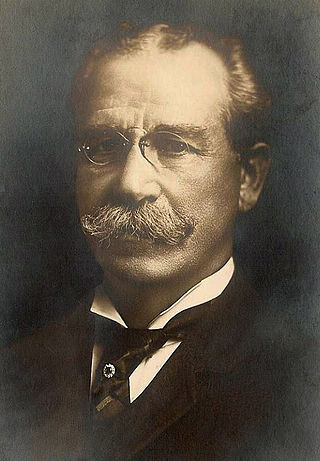
John Irvin Beggs was an American businessman. He was associated closely with the electric utility boom under Thomas Edison. He was also associated with Milwaukee, St. Louis, Missouri, and other regional rail and interurban trolley systems. Beggs is also known for developing modern depreciation techniques for business accounting and for being one of the early directors of what became General Electric.

Streetcars or trolley(car)s were once the chief mode of public transit in hundreds of North American cities and towns. Most of the original urban streetcar systems were either dismantled in the mid-20th century or converted to other modes of operation, such as light rail. Today, only Toronto still operates a streetcar network essentially unchanged in layout and mode of operation.
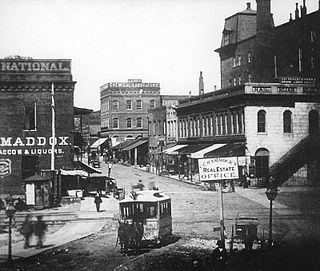
Streetcars originally operated in Atlanta downtown and into the surrounding areas from 1871 until the final line's closure in 1949.

Oneida Street Station, also known as the East Wells Power Plant, was a power plant operated by The Milwaukee Electric Railway & Light Company. Constructed from 1898 to 1900, it was designed by architect Herman Esser in neoclassical revival style. The building is located in downtown Milwaukee, Wisconsin, at the Milwaukee River and Wells Street, which was once known as Oneida Street. The company began operating electric street cars in 1890. Their expanding network of streetcar and interurban railway lines were powered by several of their own power plants. As the company generated more power than they used, they sold the excess electricity, and, as Wisconsin Energy Corporation, eventually became the major supplier of power to eastern Wisconsin. The American Society of Mechanical Engineers (ASME) describes the plant as the "first central power station in the United States to be equipped and successfully operated with pulverized coal."
Streetcars in Los Angeles over history have included horse-drawn streetcars and cable cars, and later extensive electric streetcar networks of the Los Angeles Railway and Pacific Electric Railway and their predecessors. Also included are modern light rail lines.
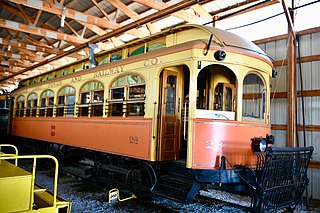
Sheboygan Light, Power and Railway Company Car #26 is a wooden interurban electric rail car built in 1908 that carried passengers on the line between Sheboygan and Elkhart Lake, Wisconsin for 30 years, until the spread of automobiles made passenger rail service non-viable. Today, the car is operated by the East Troy Railroad Museum on their East Troy Electric Railroad, carrying visitors on their track in East Troy.

The Hop, also known as the Milwaukee Streetcar, is a modern streetcar system in Milwaukee, Wisconsin. The system’s 2.1-mile (3.4 km) original “M” line connects the Milwaukee Intermodal Station and Downtown to the Lower East Side and Historic Third Ward neighborhoods. In October, 2023, a 0.4-mile (640 m) Lakefront, or “L” line, to the still under-construction high-rise development The Couture, began limited Sunday service, and will offer daily service beginning in early 2024. The system is owned by the city and operated by Transdev.

The Waukesha Beach Railway operated from 1895 until 1949 as an interurban railway from Waukesha to Pewaukee Lake in Wisconsin.

The Lake Country Trail is a paved multipurpose rail trail in Waukesha County, Wisconsin. It stretches 15.2 miles (24.5 km) from the intersection of W Jefferson St. and S Franklin St. in Oconomowoc to the Landsberg Center Trailhead on Golf Rd. in Pewaukee. It also passes through the Wisconsin communities of Summit and Delafield.

The Milwaukee & Suburban Transport Corporation, commonly known as the Transport Company, was a public transport company in Milwaukee, Wisconsin.




















